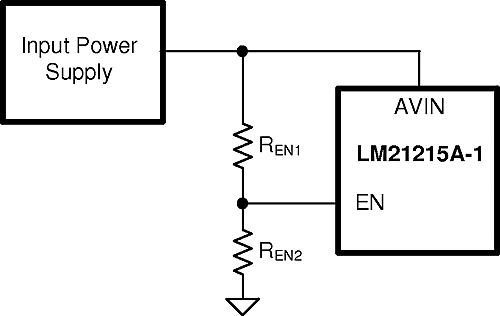SNOSB87D March 2011 – May 2019 LM21215A
PRODUCTION DATA.
- 1 Features
- 2 Applications
- 3 Description
- 4 Revision History
- 5 Pin Configuration and Functions
- 6 Specifications
- 7 Detailed Description
- 8 Application and Implementation
- 9 Power Supply Recommendations
- 10Layout
- 11Device and Documentation Support
- 12Mechanical, Packaging, and Orderable Information
Package Options
Mechanical Data (Package|Pins)
- PWP|20
Thermal pad, mechanical data (Package|Pins)
- PWP|20
Orderable Information
8.2.1.2.3 Precision Enable
The Enable (EN) pin of the LM21215A allows the output to be toggled on and off. This pin is a precision analog input. When the voltage exceeds 1.35 V, the converter begins to regulate the output voltage as long as AVIN has exceeded the UVLO threshold voltage of 2.7 V. There is an internal pullup current source of 2 µA connected to EN. If enable is not used, the device turns on automatically. Also, if EN is not toggled directly, the device can be set to turn on at a certain input voltage higher than the internal UVLO rising threshold. This is achieved with an external resistor divider from AVIN to EN and EN to AGND as shown in Figure 30.
 Figure 30. Input Voltage Turn-on Setpoint Configured by Enable Resistor Divider
Figure 30. Input Voltage Turn-on Setpoint Configured by Enable Resistor Divider The resistances of REN1 and REN2 are chosen to allow EN to reach its rising threshold voltage at the desired the input supply voltage. With the enable current source included, use Equation 4 to solve for REN1.

where
- REN1 is the resistor from VIN to EN
- REN2 is the resistor from EN to AGND
- IEN is the internal enable pullup current (2 µA)
- 1.35 V is the precision enable rising threshold voltage
Typical values for REN2 range from 10 kΩ to 100 kΩ.